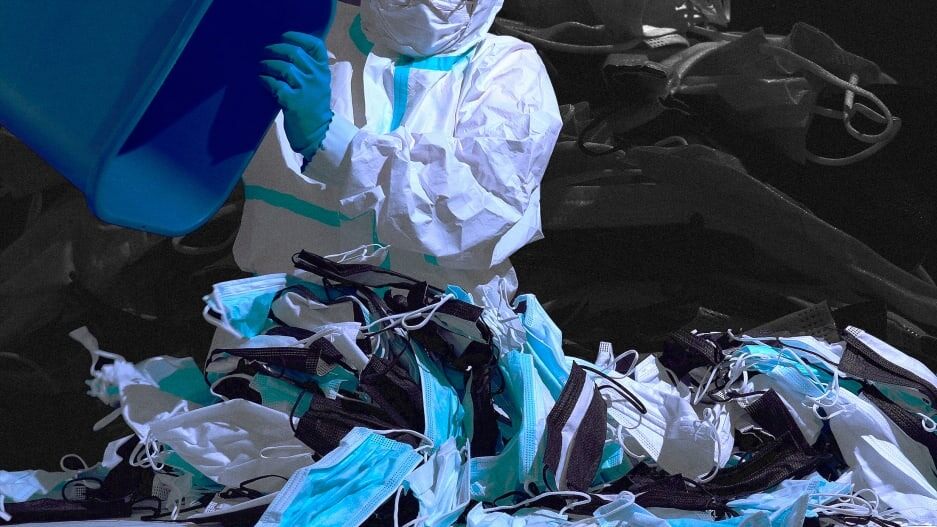- | 7:30 am
Remember all the disposable stuff you used when COVID-19 hit? It made the plastic crisis much, much worse
The plastics industry lied to us to sell us more masks and disposable bags during the pandemic. How do we turn things around?

Plastic filled our lives during the pandemic, littering our world with N95 masks, take-out containers, and single-use grocery bags.
While the world was fixated on the global health crisis, the plastic crisis only got worse. Plastic products like PPE and disposable packaging were marketed as tools in the fight against COVID-19.
In a new book, Plastic Unlimited, researcher Alice Mah says it didn’t have to be this way. (We published an excerpt of her book here.) She argues that plastic corporations knowingly pushed false claims about the benefits of plastic during the pandemic in order to increase sales. And as life returns to normal, she says it’s crucial for companies and consumers to dramatically cut down on plastic production.
In the years before the pandemic, consumers became increasingly worried about plastic, Mah says. In 2017 and 2018, stories about sea creatures dying from plastic pollution went viral, including a harrowing image of a turtle with a straw lodged up its nose. There was growing awareness about microplastics, tiny particles of plastic that end up in the food chain, harming our bodies. And given that most disposable plastic is incinerated, it also contributes to climate change. All of this led to a wave of activism that resulted in companies like Starbucks vowing to eliminate plastic straws and states like California and New York banning plastic bags.
This anti-plastic sentiment was so powerful that corporations took notice. “I noticed in my research with these petrochemical companies—these plastics companies—that there was a panic about how bad the public perception of plastics was and how they really needed to turn the narrative around,” Mah says. “I saw how they very rapidly organized to embrace a narrative around the circular economy and recyclability.”
But then, Mah says, the pandemic struck, which turned out to be a gift for the plastic industry. Companies were able to make the case that plastic was hygienic and could help keep the virus at bay, and lobbied to reverse plastic bag bans. But these claims weren’t true. There were peer reviewed studies that COVID-19 could survive on plastic surfaces for up to three days, longer than most other materials, including cardboard.
In 2020, Greenpeace published a research brief saying that the plastics industry had manipulated the media with misleading claims that disposable plastic goods were more sanitary than reusable ones, exploiting anxiety about the pandemic to churn out more products. But by then, consumers already felt confident that plastic could keep them safer. “At the time of the pandemic, you saw a resurgence of single-use plastics,” Mah says. “There was amnesia about the turtles with the straws up their nose.”
It wasn’t just PPE that flooded the market. It was also changes in our consumption during lockdown. As restaurants shut down, consumers turned to take-out, which comes in plastic containers, and e-commerce, which requires everything from bubble wrap to poly bags that wrap individual products. The nonprofit Oceana estimates that Amazon was responsible for 485 million pounds of packaging waste in 2019, a volume that would have increased by 38% in 2020 along with its increased sales.
Mah says that even she felt guilty about the volume of plastic that entered her home in the U.K. during the pandemic. And while it’s true that people in the U.K. and U.S. generate between 218 and 240 pounds of plastic a year, which is double the global average, it’s also true that consumers are trapped in a society where plastic is ubiquitous. It’s very hard to go to the grocery store and ask for your meat, cereal, or vegetables not to be packaged in plastic, for instance. “People are locked into supply chains and infrastructures, unable to simply opt out of plastic consumption,” she says.
So what’s the solution? Consumers can—and should— work to reduce their personal plastic consumption, but Mah argues that we need global, systemic solutions to get plastic out of our lives. The answer isn’t recycling, which comes with its own environmental costs; instead, we need to eliminate plastic as much as possible.
In some ways, it’s worth thinking about plastic along the same lines as climate change, she says. One possible answer is for the United Nations to create an agreement similar to the Paris Climate Accord, but for plastic. A version of such a treaty is currently being discussed by the UN Environment Assembly, but it would take years to negotiate the complex details.
Governments must also play a role, because plastic corporations are unlikely to voluntarily reduce their own production. Legislators can pass outright bans on single-use plastics, which India did this month, forbidding the use of 19 plastic items like cups, straws, and ice-cream sticks. Governments can also hold companies accountable for the full lifecycle of their products, forcing them to pay for any pollution created when the item is thrown out. The European Union and Canada require plastic producers to pay for waste collection and management.
Ultimately, however, curbing plastic will mean redesigning almost every aspect of our lives. We will need to rethink the systems of food, shopping, transportation, logistics, public health, construction, and many other industries in order to fully excise plastic. This will mean moving away from our addiction to disposable products, and shifting toward durable, reusable goods. “Plastic has been seen as a miracle material that can be transformed into almost anything,” May says. “It is cheap, but if you calculate all the costs—the people who die of toxic exposure, the loss of clean water, the impact on our ecosystems—it’s not really that cheap. I don’t think the solution is to come up with some other magical material, but to learn how to live without it.”





































